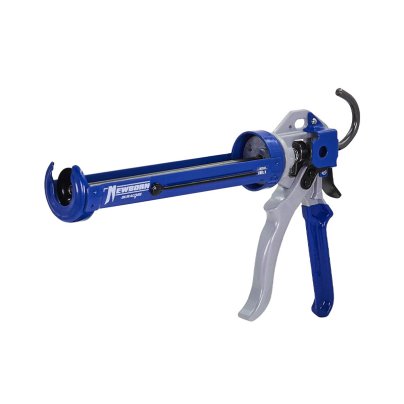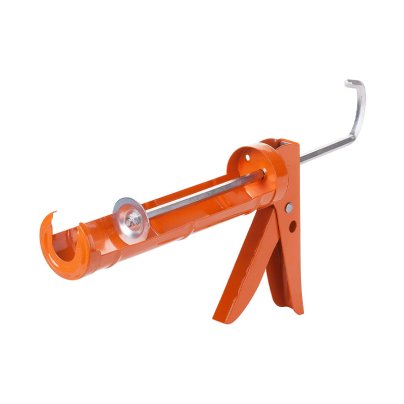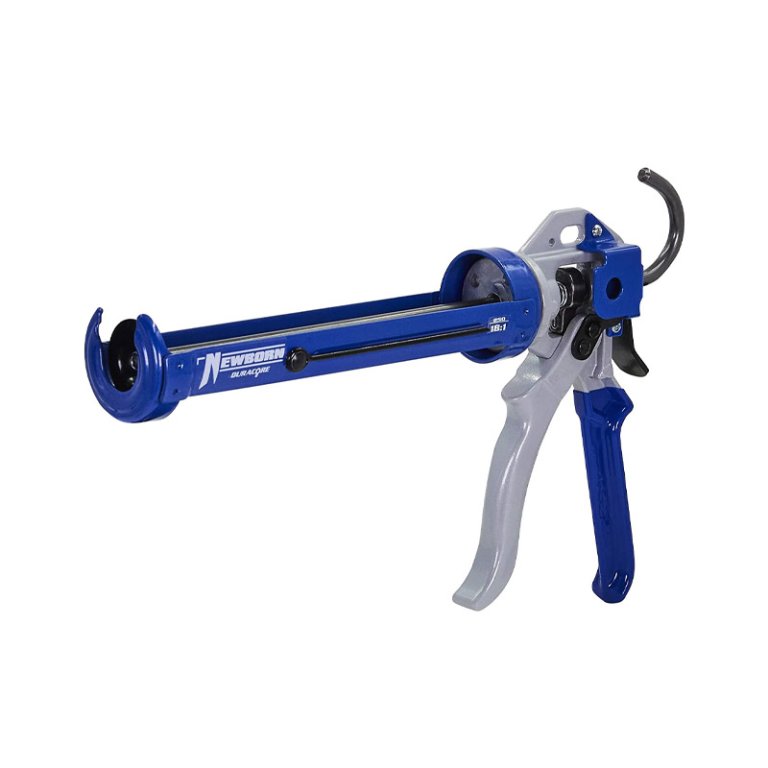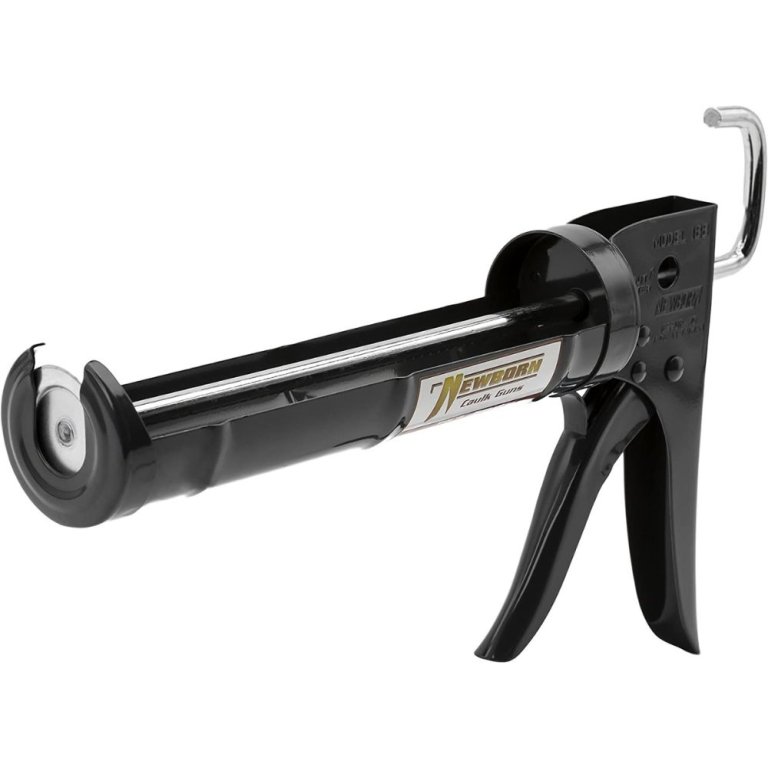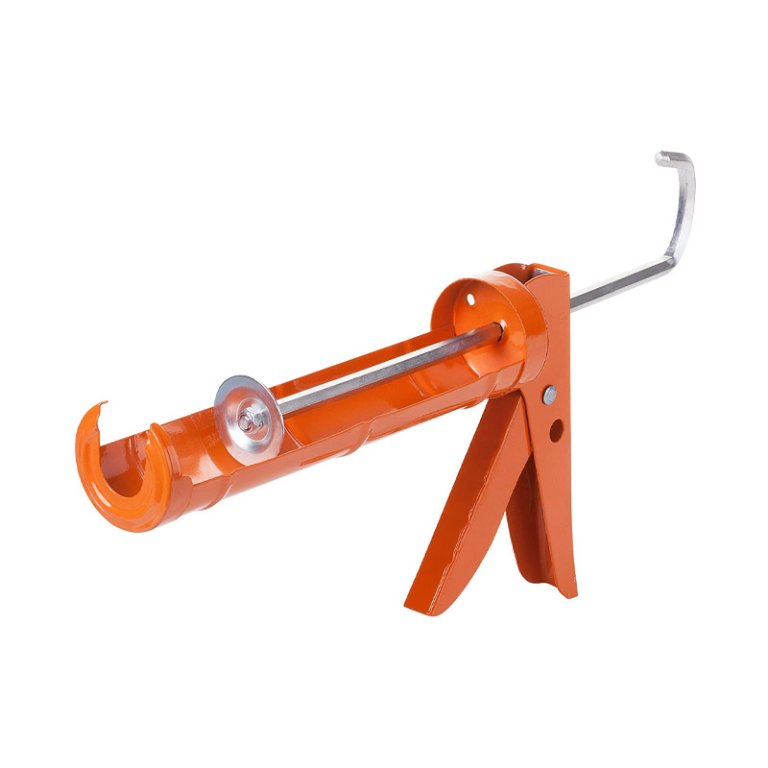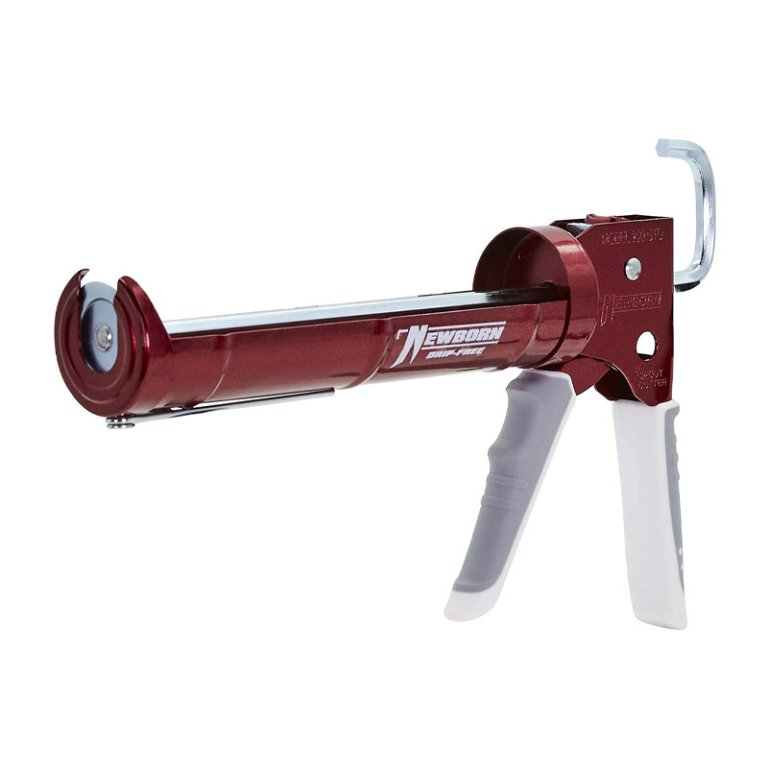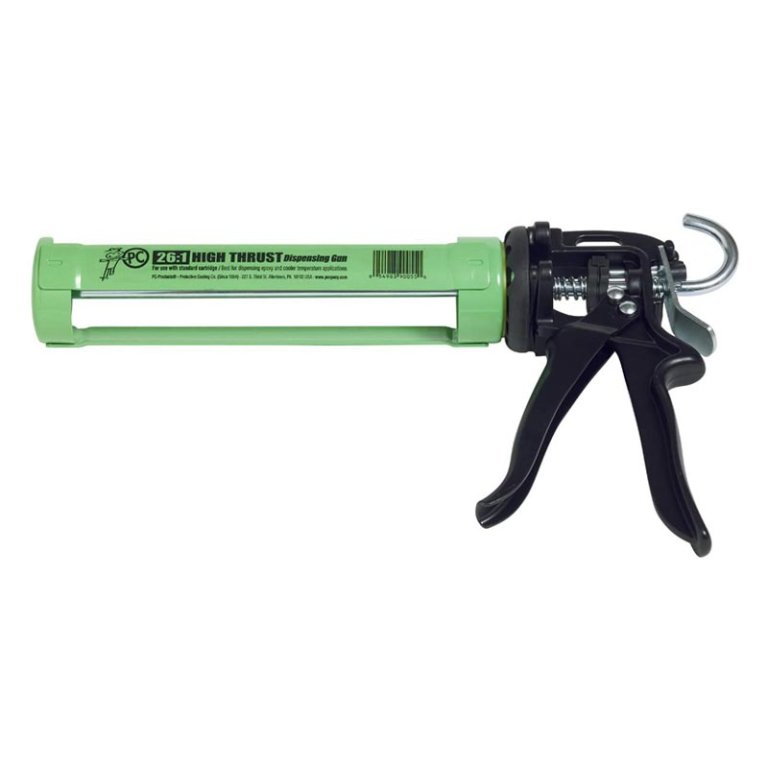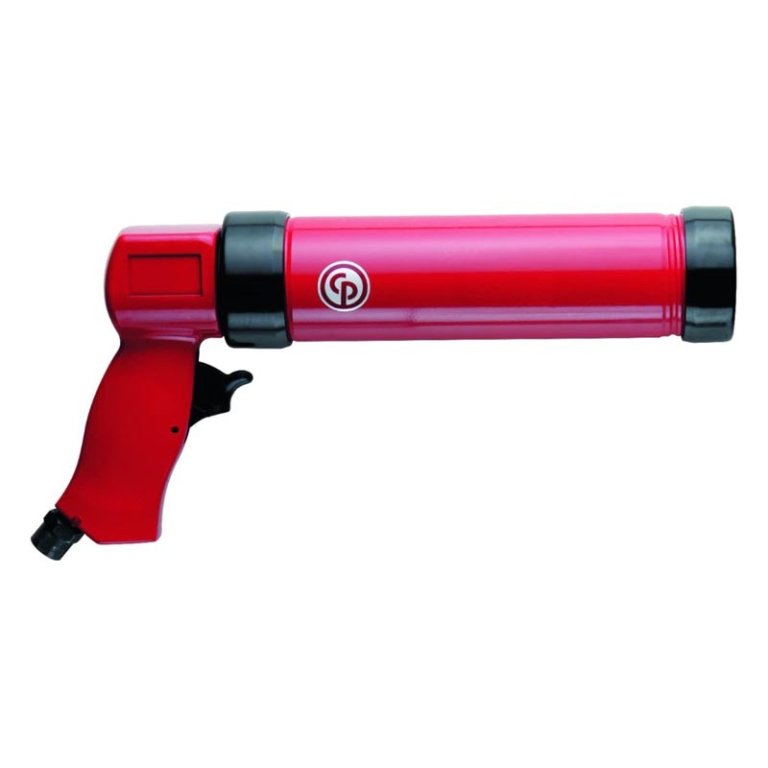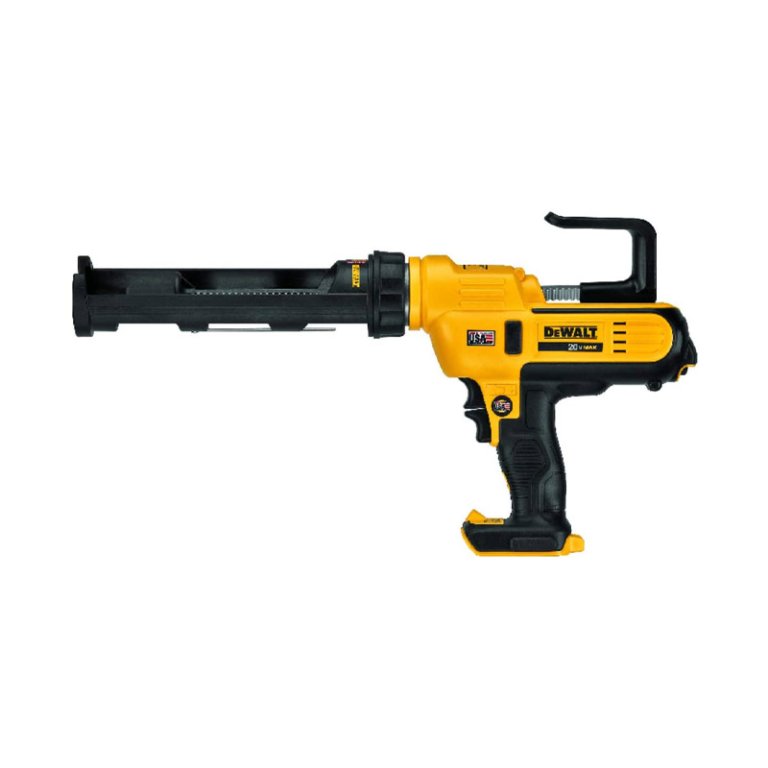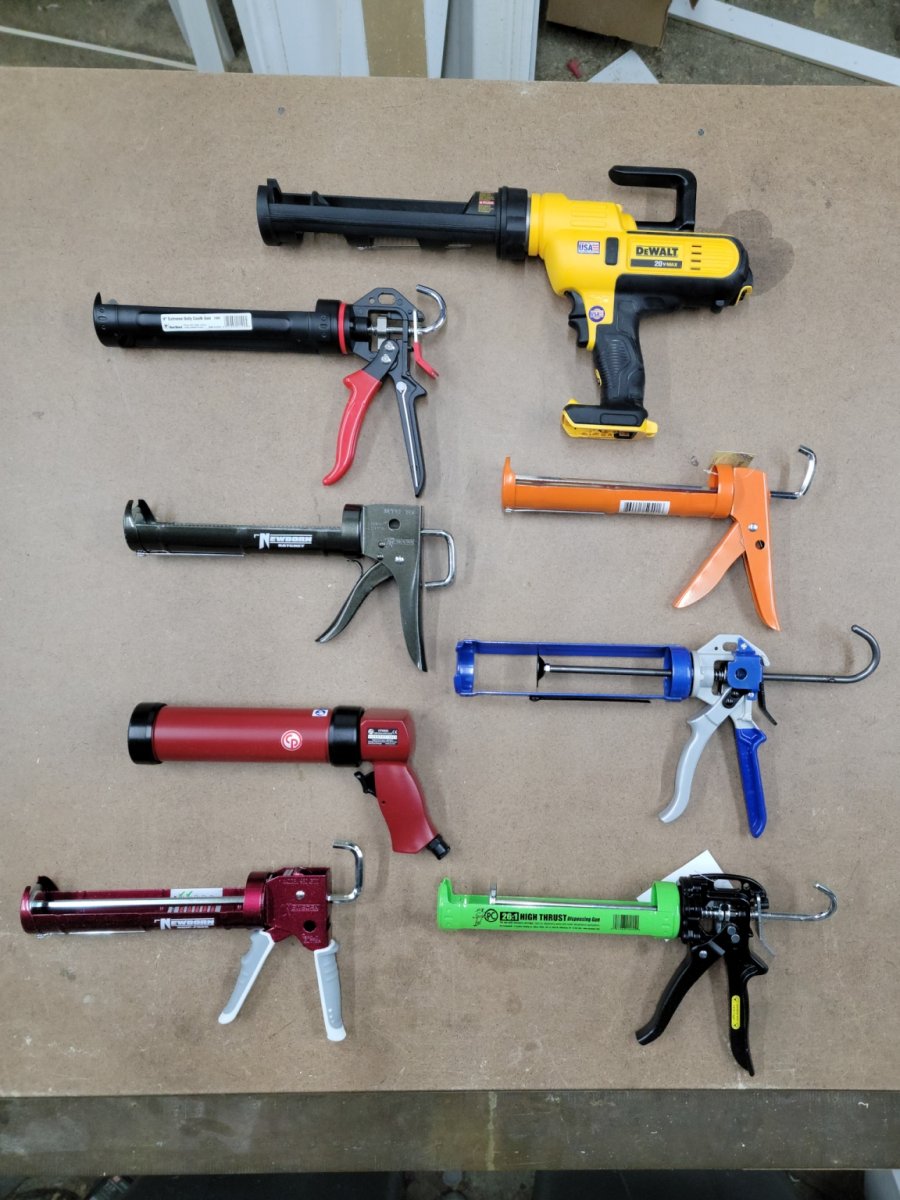
We may earn revenue from the products available on this page and participate in affiliate programs. Learn More ›
Caulking guns deliver a continuous bead of caulk to seal joints between two surfaces, such as gaps between window frames and jambs. Most caulking guns today are manual, meaning you squeeze a hand trigger to dispense the sealant. However, powered caulking guns are growing in popularity because all you need to do is guide the tip to create a smooth, continuous bead of caulk.
Choosing the ideal caulking gun will depend on the type of caulk you’re using, as well as the project’s overall scope and budget. To help you decide, we tested eight popular options in real-world applications and contacted an expert to get their insights. Based on our hands-on tests and our expert’s experience, we chose the Newborn 250 Smooth Rod Revolving Frame Caulking Gun as the best overall option. It’s comfortable to grip, easy to use, and offers the smoothest rotation of all tested models.
We’ve included the rest of our recommendations on the best caulking guns below, as well as useful tips for how to choose the tool that’s right for you.
- BEST OVERALL: Newborn 250 Smooth Rod Revolving Frame Caulking Gun
↓ Jump to Review - RUNNER-UP: Newborn 188 Ratchet Rod Cradle Caulking Gun
↓ Jump to Review - BEST BANG FOR THE BUCK: Bates Choice 10:1 Thrust Ratio Caulking Gun
↓ Jump to Review - BEST GRIP: Newborn Octogun 930-GTD Hex Rod Cradle Caulking GunGun
↓ Jump to Review - BEST FOR THICK SEALANTS: PC Products Steel Dispensing Caulking Gun
↓ Jump to Review - BEST HEAVY-DUTY: Chicago Pneumatic CP9885 Series Caulking Gun
↓ Jump to Review - BEST BATTERY: DeWalt DCE560B 20V Max Adhesive Gun
↓ Jump to Review - ALSO CONSIDER: Red Devil 9-Inch Extreme Duty Caulking Gun
↓ Jump to Review
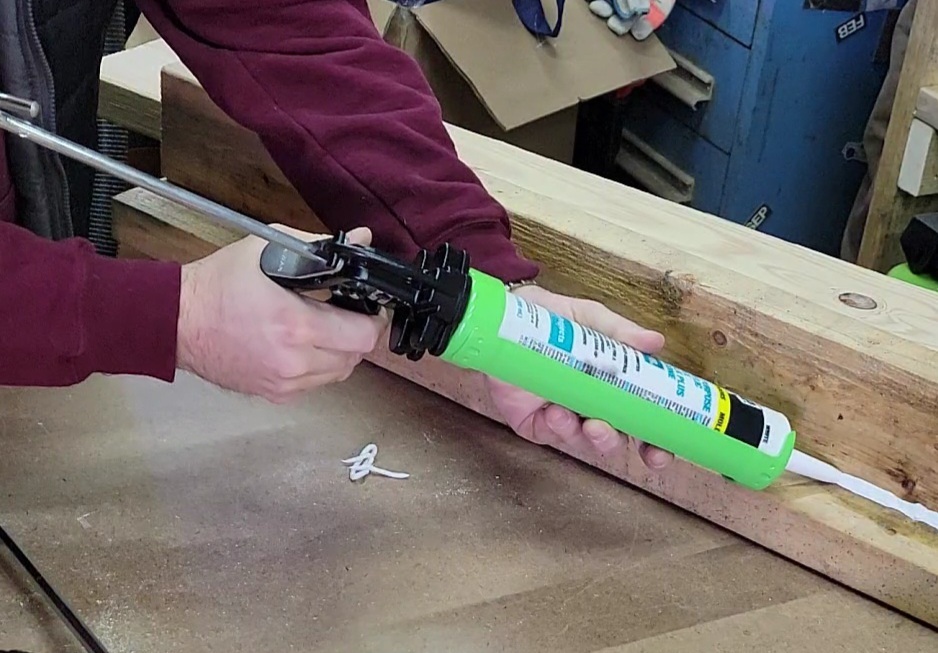
Caulking Guns Comparison Chart
| Product Name | Rod Type | Thrust Ratio | Revolving? |
| Newborn 250 Smooth Rod Revolving Frame Caulking Gun | Smooth | 18:1 | Yes |
| Newborn 188 Ratchet Rod Cradle Caulking Gun | Ratcheting | 6:1 | No |
| Bates Choice 10:1 Thrust Ratio Caulking Gun | Smooth | 10:1 | No |
| Newborn Octogun 930-GTD Hex Rod Cradle Caulking Gun | Smooth | 10:1 | No |
| PC Products Steel Dispensing Caulking Gun | Smooth | 26:1 | Yes |
| Chicago Pneumatic CP9885 Series Caulking Gun | None | N/A | No |
| DeWalt DCE560B 20V Max Adhesive Gun | Smooth | N/A | Yes |
| Red Devil 9-Inch Extreme Duty Caulking Gun | Smooth | 26:1 | Yes |
Our Top Picks
There’s a lot to consider when choosing the best caulking gun, and the sheer volume of information can feel overwhelming. To help you fill in the gaps, we detail the results of our hands-on tests and each item’s pros and cons below.
Best Overall
Newborn 250 Smooth Rod Revolving Frame Caulking Gun
See ItWhat We Like
- Smooth rotation makes applying caulk and sealant easy
- Comfortable grip reduces hand fatigue
- Built-in cutter cuts spouts cleanly and efficiently
What We Don’t Like
- Rubber coating on just 1 grip instead of 2
Specs
- Rod type Smooth
- Thrust ratio 18:1
- Revolving Yes
During testing, we found applying caulk and sealant using the Newborn 250 easy and smooth. The frame rotates smoothly (certainly the smoothest of all the models), and the hand grips are very comfortable. It also has a revolving frame, making it much easier to caulk around corners. Instead of having to stop and restart, simply rotate the barrel, and the angled tip of the tube rotates to the correct position to continue running a bead.
The Newborn 250 is built to last with a handle made of zinc alloy to reduce corrosion. The tool features a hefty 18:1 thrust ratio to easily dispense medium-viscosity caulk, including butyl and acrylic. It also has a thumb release for dripless operation, and we really liked the built-in cutter (which most high-thrust caulking guns don’t have). This model does drip a bit, but the release is easy to access and press with one hand. Our only complaint is that just one handle has a rubber coating—coating both handles would be a benefit.
What our tester says: “The frame on this model rotated more smoothly than all the other units we tested, making it incredibly easy to apply caulk and sealant evenly.”—Tom Scalisi, Product Reviews tester and writer
Get the Newborn 250 caulking gun at Amazon, Ace Hardware, Lowe’s, or Newborn.
Runner-Up
Newborn 188 Ratchet Rod Cradle Caulking Gun
See ItWhat We Like
- Built-in cutter and puncture tool
- Sturdy welded construction will stand the test of time
- Ratchet pressure rod mitigates dripping
What We Don’t Like
- Tougher to squeeze than other models
Specs
- Rod type Ratcheting
- Thrust ratio 6:1
- Revolving No
For occasional small projects, such as caulking between a shower or bathtub and the wall, check out this nicely priced and super-dependable option from Newborn. The 188 ratchet rod cradle caulking gun has a traditional ratchet rod design and a 6:1 thrust ratio that’s best for dispensing low-viscosity sealant, such as painter’s latex caulk. It comes with a built-in pin for puncturing the seal on the caulk tube and a built-in cutter to nip off the tube’s tip.
During testing, we found quite a few things to like about the Newborn 188. For one, we appreciated the sturdy welded construction, which felt quality despite this option’s reasonable price tag. We also liked the built-in cutter and puncture tool, which made getting to work faster and easier. The one downside we found was that this caulking gun was more difficult to squeeze than others, making it best for small projects.
Get the Newborn 188 caulking gun at Amazon or Lowe’s.
Best Bang for the Buck
Bates Choice 10:1 Thrust Ratio Caulking Gun
See ItWhat We Like
- Affordable price without lacking features
- True no-drip functionality
- Offers consistent and reliable performance
What We Don’t Like
- Grip handles are uncomfortable
Specs
- Rod type Smooth
- Thrust ratio 10:1
- Revolving No
Finding a caulking gun that really offers a no-drip design can be difficult—even more so at a reasonable price point. But this Bates Choice model checks both boxes. This simple caulking gun features a smooth rod that provides even and consistent pressure without dripping. It also has a 10:1 ratio, which is more than most other models at this price. It has a lightweight fixed frame, as well as a built-in cutter and puncture wire.
Our first impression of the Bates was that it felt rather cheap. It did, however, accomplish something no other caulking gun in the comparison did: It didn’t drip at all. When we considered that alongside its affordable price, the Bates really stood out. We also liked that it had a built-in cutter and a puncture tool under the frame to make getting started easier.
Get the Bates Choice caulking gun at Amazon, Walmart, or Bates Choice.
Best Grip
Newborn Octogun 930-GTD Hex Rod Cradle Caulking Gun
See ItWhat We Like
- Comfortable thermoplastic grip prevents hand fatigue
- Smooth rod is easy to release and adjust
- Makes an excellent silicone caulking gun
What We Don’t Like
- No dripless as claimed
Specs
- Rod type Smooth
- Thrust ratio 10:1
- No
Anyone trying to avoid tired hands while caulking and sealing may find this unit from Newborn ideal. It has two rubber overmolded grips, a smooth-pull hand trigger, and a rod that automatically retracts after releasing the trigger to prevent excess caulk from oozing out. It also features a 10:1 thrust ratio and easily dispenses light to light-medium viscosity caulk, making it well suited for latex and silicone.
This gun has a built-in seal puncturing tool, a cutting tool, and a handy hook for hanging on a ladder rung. We like that we can cut the tips of our caulking tubes and puncture the seal without having to reach for other tools, and this caulking gun’s smooth rod is easy to adjust and release. The one thing we don’t love about this caulking gun is that its so-called “dripless caulk gun technology” is not as no-drip as advertised. It definitely dripped a little for us.
What our tester says: “This tool’s grip really stood out during testing. It’s extremely comfortable and easy to squeeze, despite this gun not having a tremendous thrust ratio.”—Tom Scalisi, Product Reviews tester and writer
Get the Newborn 930-GTD caulking gun at Amazon.
Best for Thick Sealants
PC Products Steel Dispensing Caulking Gun
See ItWhat We Like
- Revolving frame is easy to maneuver in hard-to-reach areas
- Great for thicker sealant materials and adhesives
- Puncture wire tucks away in the trigger
What We Don’t Like
- No tip cutter
Specs
- Rod type Smooth
- Thrust ratio 26:1
- Revolving Yes
With a high thrust ratio of 26:1, the PC Products steel caulking gun is a workhorse that smoothly dispenses thick sealants. Thanks to its high ratio, it also works for caulks, sealants, and adhesives at low temperatures. It features a smooth rod and a thumb release to prevent oozing and waste. It has a revolving frame that makes positioning the tube easy, especially when laying caulk around corners.
Testing the PC Products steel caulking gun was enjoyable. Despite below-freezing temperatures, it had plenty of thrust for squeezing out sealant, and we liked that the frame revolves. While it does have smart puncture wire storage (it’s spring-loaded behind the trigger), it doesn’t feature a cutter, which could be a downside for some.
Get the PC Products caulking gun at Amazon,The Home Depot, or Walmart.
Best Heavy-Duty
Chicago Pneumatic CP9885 Series Caulking Gun
See ItWhat We Like
- Drips very little for a professional finish
- Easy on the hands since everything is done using pressure
- Creates an even bead; great for awkward areas
What We Don’t Like
- Requires an air hose
Specs
- Rod type None
- Thrust ratio N/A
- Revolving No
If you have a large caulking project on the horizon, such as caulking windows throughout your house or constructing a full set of cabinets in a workshop, the Chicago Pneumatic caulking gun might be exactly what you need. Instead of offering labor-intensive manual operation, it attaches to an air compressor for efficiency and ease of use.
This caulking gun also doesn’t have a plunger. Instead, it pressurizes the space behind the caulk to push it through the tube, allowing for consistent pressure. It comes with a regulator to adjust the pressure for optimal flow as well.
Admittedly, it took us a little while to dial in this caulking gun’s pressure regulator, which did cause a bit of a mess at first. But, once dialed in, it was wonderful to test. Releasing the trigger immediately drops the pressure behind the tube, and as a result, there’s very little dripping. Also, once we adjusted the regulator, it offered consistent and smooth pressure. In addition to an air compressor, it requires an air compressor hose for operation.
Get the Chicago Pneumatic caulking gun at Amazon or Walmart.
Best Battery
DeWalt DCE560B 20V Max Adhesive Gun
See ItWhat We Like
- Uses batteries DeWalt users already have
- Adjustable speeds allow custom settings
- Onboard work light illuminates dark work areas
- Swiveling frame increases accuracy in tight spots
What We Don’t Like
- A bit expensive and doesn’t come with a battery
Specs
- Rod type Smooth
- Thrust ratio N/A
- Revolving Yes
When it comes to large caulking or adhesive projects, this DeWalt cordless caulking gun might be the tool for the job. This model uses power from DeWalt’s 20-volt battery lineup (not included but commonly owned by many DIYers) to squeeze caulking tubes with consistent, repeatable results. Since you only need to hold down the trigger, it’s comfortable to use for extended periods without hand fatigue.
During testing, the DeWalt caulking gun produced even and consistent results without wearing out our hands. We enjoyed its onboard work light while applying silicone caulk in dark corners, as well as its swiveling frame. It also has six adjustable speeds, allowing you to dial in the correct rate for whatever job you’re working on. While all these features come at a relatively high price, we think anyone applying construction adhesive to floor joists will find this caulking gun pays for itself in a day or two.
Get the DeWalt caulking gun (tool only) at Lowe’s or Walmart.
Also Consider
Red Devil 9-Inch Extreme Duty Caulking Gun
See ItWhat We Like
- Handle is comfortable yet grippy enough to feel solid
- Plenty of power to accommodate thicker sealants
- Quick-release lever, seal puncture tool, and ladder hook
What We Don’t Like
- Dripped during our tests
- Frame doesn’t swivel smoothly
Specs
- Rod type Smooth
- Thrust ratio 26:1
- Revolving Yes
With a 26:1 thrust ratio for squeezing thick sealants and caulks out of their tube, Red Devil’s Extreme Duty caulk gun is worth considering for working at low temperatures or with thick adhesives. It features a smooth rod for quick release as well as a swiveling frame for caulking around corners. It also has a comfortable rubber-coated trigger and a built-in seal puncture wire in the handle.
In some areas, the Red Devil was excellent during testing. The rubber grip was comfortable yet grippy, and there was plenty of power for squeezing out caulk or sealant in cold temperatures. Unfortunately, this model is marketed as a dripless caulking gun, but it dripped during testing. Its frame also doesn’t swivel smoothly, but we got used to that and felt the sealant gun deserved a spot on our list for its sturdy build quality and power.
Get the Red Devil caulking gun at Amazon or Walmart.
Jump to Our Top Picks
How We Tested the Best Caulking Guns
Testing caulking guns was pretty straightforward: load them up, test their power, see if they drip, and compare the results. But since temperatures were just under freezing when we tested the caulking guns, our efforts really put them through the wringer.
We tested each refillable caulking gun using an acrylic caulk to see how smooth, consistent, and easy they were to work with. We caulked a seam between two boards and then allowed the guns to rest to see how much they’d drip. We took note of features like rods, built-in cutters, puncture wires, and rubber grips.
We then loaded the caulking guns with cold construction adhesive as well as roofing tar and ran a bead of each down the board. This showed us which guns had the best power and which were difficult to use in those conditions. We also checked for drips, which were considerably fewer than the acrylic due to the adhesive’s viscosity.
What to Consider When Choosing a Caulking Gun
Choosing a caulking gun might seem like a straightforward proposition, but there is actually quite a bit to know about these tools. From the type of rod, power vs. no power, thrust ratio, and more, it’s worth doing a bit of research. The following are some of the most important factors to consider when searching for the best caulking gun.
Caulking Gun Type
Repeatedly squeezing a trigger can lead to hand and wrist fatigue, which is why powered caulking guns are becoming more popular. When they first hit the market a few years ago, powered caulking guns were reserved for commercial and industrial projects. Today, DIYers are discovering the benefit of caulking with a gun that automatically dispenses sealant so they can focus on creating a smooth bead. Since an automatic caulking gun doesn’t have a hand trigger, thrust ratio does not apply. Instead, dispensing pressure is regulated via a light squeeze on the finger trigger.
- Electric caulking guns come with a cord and require access to an electrical outlet. Light pressure on a finger trigger allows users to dispense just the right amount of sealant.
- Battery-powered caulking guns use rechargeable batteries, which allows users to run a bead of caulk in locations where electricity isn’t available, such as in an under-construction bathroom or shower. Since they generally only store enough power for 2 to 3 hours of use per charge, investing in an extra battery to accommodate large jobs is probably worth it.
- Pneumatic or air-powered caulking guns are among the most popular powered options for home workshops because they don’t require a battery and are interchangeable with other air-power tools. However, you will need a home air compressor to run one. In addition to the gun’s finger trigger, dispensing pressure can be regulated by adjusting the pressure on an air compressor.
- Though it sounds like a breakfast tool, a sausage caulking gun is actually designed to hold collapsible foil cylinders of sealant called “sausages.” These caulking guns, which operate in the same manner as others (manual or powered), let users squeeze every last bit of sealant from the sausage, so there’s very little waste.
Rod Type
Squeezing the hand trigger on a manual caulking gun forces a rod into the back of the tube of interior or exterior caulk, which in turn pushes the caulk out of the tube’s tip. There are two main types of gun rods, and they vary slightly in performance.
- Ratchet rod: Caulking guns with ratchet rods have serrated rods that “catch” with each hand squeeze. They are usually inexpensive and suitable for light projects. The biggest problem with ratchet rods is that the sealant can keep oozing caulk out until the end of the rod is twisted and pulled back to release the pressure. This oozing can make a mess and lead to wasted sealant.
- Smooth rod: When applying caulk with a smooth rod caulking gun—often advertised as “dripless”—the user only needs to depress a thumb lever to release pressure on the sealant to stop it from leaving the tube.
Thrust Ratio
Thrust ratio relates to the amount of force generated each time the hand trigger is squeezed. The higher the ratio, the more force is exerted with each squeeze. This is important because different types of sealant are more or less viscid (thick). With thicker sealants, more thrust ratio is required to dispense the sealant.
Thrust ratios range from 3:1 to 28:1. Guns with lower ratios are suitable for dispensing thin caulk, such as water-based latex caulk, while higher thrust ratios are needed for dispensing more viscous caulk, such as epoxy sealants.
Revolving Frame
Stopping and starting when running a bead of caulk can lead to unsightly lumps and bulges. It’s especially challenging to run a continuous bead around a corner because your hand position and the angle of the gun must change. With a revolving frame, however, you simply rotate the frame (instead of the whole gun) when rounding a corner to caulk without interruption.
FAQs
If your head is spinning with information or unresolved questions, the following answers may clear things up. We also offer more information on whether you can caulk over caulk and top caulking mistakes in separate guides.
We found the Newborn 250 caulking gun the easiest to use during testing. It has plenty of power, a comfortable grip, and a swivel frame. It also drips less than most other models on our list.
Some manufacturers sell squeeze tubes of caulk, which don’t require a gun and can be great when working above cabinets or in tight spaces. However, without a caulking gun, applying an even and consistent bead can be difficult, so we don’t recommend using squeeze tubs for precision applications.
Caulking guns come in different sizes. A small caulking gun comes in a standard size of 10 ounces. All the caulking guns on this list are 10-ounce models. If you need a large caulk gun for heavy-duty applications, look for a 29-ounce version.
We asked Eduard Mirzoian, CEO of Restorerz, for advice on how to work a caulk gun, and he said, “Always push the trigger. Pulling the trigger doesn’t allow for proper application of pressure, which can lead to inconsistent flow and sloppy work. By pushing the trigger, you maintain control over the caulking process.”
We also asked Mr. Mirzoian this question, and he told us that caulking guns don’t have to be expensive. He said it’s more important to prioritize the viscosity of the caulk you’ll be using and user-friendly features like drip-free performance and adjustable flow control.
In addition to choosing a dripless caulking gun, a couple of simple caulking tips and tricks can help keep your gun from dripping. Start by storing caulking tubes upright for several hours or overnight before use. This will give trapped air time to rise, allowing it to escape as soon as you open the tube. Then, after cutting the tip, bang the bottom of the tube several times on a hard surface before placing it in your gun to further release excess air.
The tested and reviewed caulk guns on our list cost between $10 and $200, with most models falling under $50. How much you pay for one will be determined by how often you use it as well as the type of gun you want.
